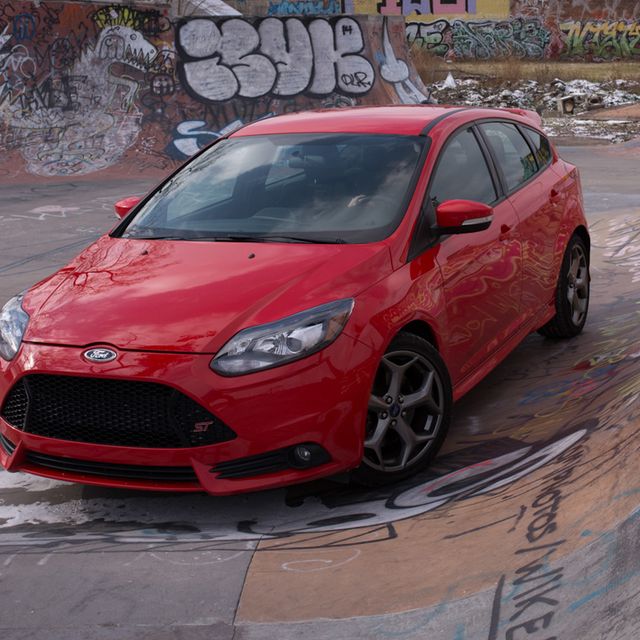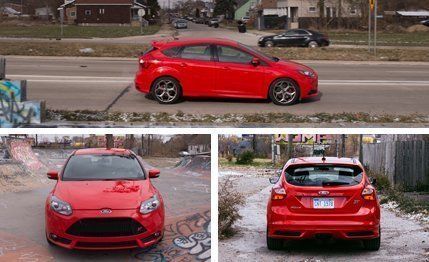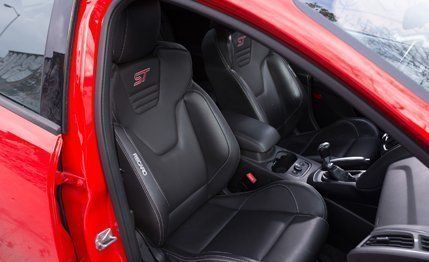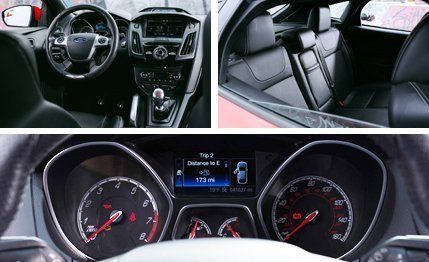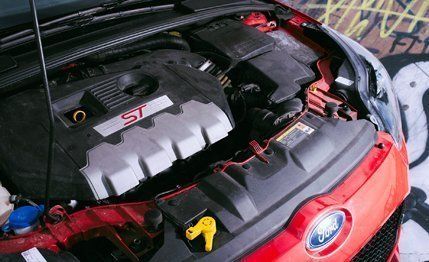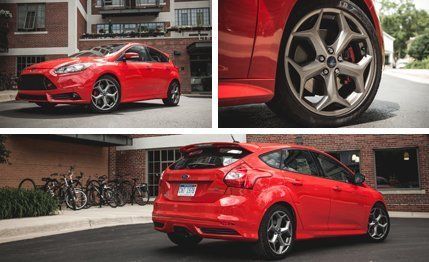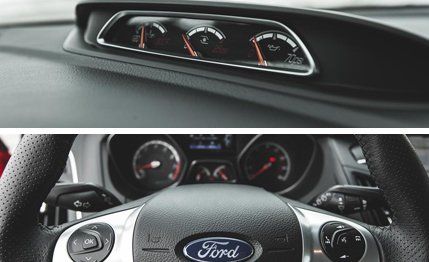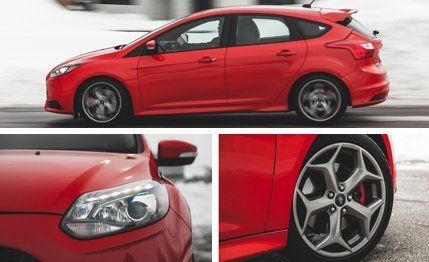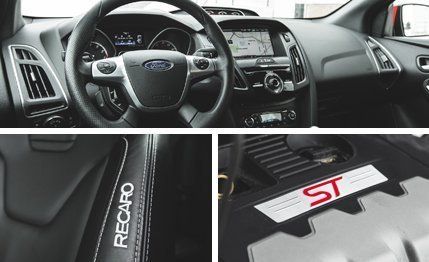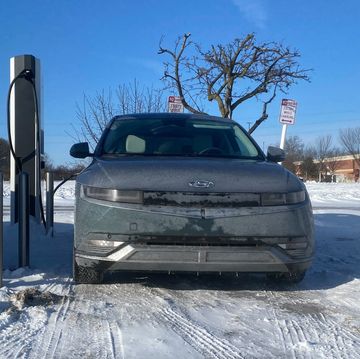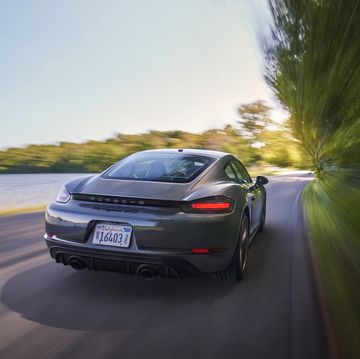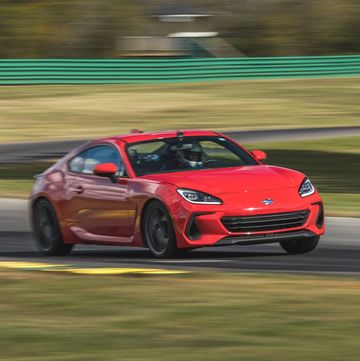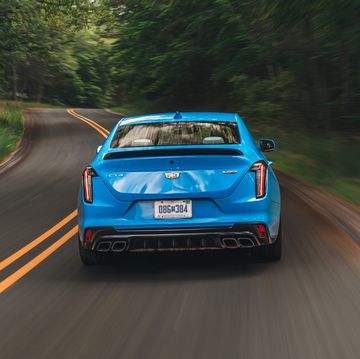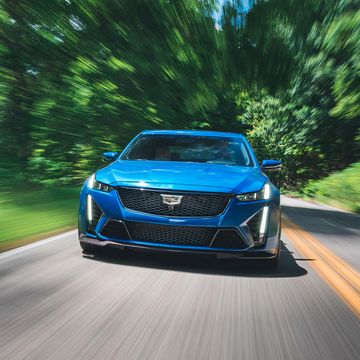Hand a 16-year-old the keys to a new Ford Focus ST and odds are the kid will be relegated to the bus by the time he’s 17. This, the hottest Focus, will turn any driver, especially one with little to no self-control, into a juvenile neighborhood terror. Of course, it’s the ST’s best attributes that bring out the worst driver behavior, which makes it our kind of car.
We weren’t too surprised when the ST punched its way onto our 2013 10Best list after a comparo win against the sixth-generation Volkswagen GTI. It’s got the goods: a potent 252-hp turbo four, a slick-shifting six-speed, and a near-neutral chassis capable of making high g’s.
Its reign as the C/D hot-hatch champ came to an abrupt end in July 2013 when we got our hands on the new GTI. The VW offers all the performance of the ST but with the refinement befitting its price. To add insult to injury, the ST’s 10Best slot was seized last year by an even more affordable and equally boyish Ford offering, the Fiesta ST. Still, the Focus is a genuine gem that makes our palms sweaty, and we were excited to discover what 40,000 miles with this hooligan had in store.
This ST wasn’t our first extended waltz with the third-generation Focus. We started a long-term test of a regular SE hatch, but a few months in, it was forced off the highway in rural Colorado and onto an impromptu Baja 1000 stage. The damage was significant enough to abort that test. Ford, fortunately, sent us a new long-term Focus, but instead of another mainstream model, it was the race-red ST seen here.
We received an almost fully loaded ST with the full-leather, heated Recaro buckets, which, unlike the partial-leather Recaros in lesser STs, are solid black instead of two-tone and don’t scream “import racer” quite as loudly. Besides the seats, bixenon headlamps and a navigation system were also part of the $4435 Equipment Group 202A. For $375, the car had gray painted wheels of the same design and 18-inch diameter as the base wheel. Our Focus rang in at just under $30,000, near the top of what most consider affordable performance.
It took less than two weeks for the young ST to throw a tantrum, albeit a small one. The Bluetooth function of the MyFord Touch infotainment system failed. Attempting to pair a new phone or a previously paired device did nothing. A mild inconvenience, but coming so early in the ST’s 40,000-mile sentence, it was cause for concern.
Showing a glimmer of initiative, a road warrior turned to internet forums before scheduling a service appointment and discovered the existence of an online update from Ford for the infotainment system. A USB drive was the only requirement. It took about 30 minutes to complete the update, and it saved us a day of dealership hassle. We’re not sure how many Focus owners actually know they can update the car’s system at home, and we bet Ford dealers like it that way.
Seat design became a story arc in early logbook entries. Even a 155-pound editor found the leg bolsters too aggressive for a long drive. He discovered that cocking his hips, and thus favoring a single leg at a time, relieved some fatigue but increased annoyance. Removing objects from pockets—including phones, pens, and billfolds the size of George Costanza’s—alleviated pressure and became habit when getting into the ST. The seat pan—or bottom cushion—also took some flack: It’s not adjustable for angle, only height, and the rear is set much lower than the front. As one editor wrote, it “cuts off circulation to the legs.”
Torque steer was also a common logbook gripe, though the entries seemed accepting, as praise for the turbocharged 2.0-liter’s power inevitably preceded or followed. Two-lane commuters loved the passing power and viewed torque steer as a necessary evil of 270 pound-feet in a front-drive car. Gentle throttle applications in first and second gears help minimize the extent to which the front wheels dart.
“It handles beautifully” and “one of the most fun cars in the fleet” are comments that perfectly describe the able and responsive chassis. The logbook bore not a single complaint about it being too stiff, an achievement considering how rutted the roads are near our office.
Despite our past complaints about Ford’s touchy infotainment interface, just a single negative comment surfaced over 40,000 miles, calling the interface obtuse and “not very smart.” Another writer noted that the nav sent them down a dead end, but that’s more likely a problem with the map database than the system logic.
While sized as a compact, the ST’s thirst isn’t small, and the tiny 12.4-gallon fuel tank also drew, er, fire. We averaged 26 mpg overall (right on its EPA-combined rating), with city driving only in the high teens and the most benign highway legs returning 30 mpg. Considering the comfort gripes, limiting the ST’s range to about 300 miles maybe wasn’t the worst decision on Ford’s part.
Our first instrumented test returned expected results. The ST is difficult to launch, and managing wheelspin with a torque curve that crests at 2500 rpm is paramount. We recorded 6.1 seconds to 60 mph and 14.7 seconds in the quarter-mile. Lateral grip, enabled by Goodyear Eagle F1 Asymmetric 2 tires that we estimate will last 35,000 miles, stressed the confining bolsters of the Recaro seats. We saw 0.94 g on the skidpad, with the electronic brake-based “limited slip” resisting inside wheelspin. And braking from 70 mph, while less-than-sports-car-short at 165 feet, did demonstrate sports-car feel in terms of pedal bite and feedback.
A consistent runner, the ST returned identical 60-mph and quarter-mile times, and even the same 96-mph trap speed, with 40,000 miles on the clock. True, the 5–60 mph, 30–50, 50–70, and all the acceleration times above 100 mph improved, indicating that a few horsepower were unleashed over its 13-month stay.
The four regular stops for fresh oil and inspections totaled $346 and came at nearly even 10,000-mile intervals. The car’s computer advises when an oil change is necessary depending on how the car is driven. The owner’s manual says 7500 to 10,000 miles is the norm. The manual also calls for replacing the cabin filter every 20,000 miles and the engine air filter every 30,000 miles, recommendations we followed.
Our unfortunate Focus luck—remember Colorado?—continued in our own downtown Ann Arbor where tech editor Eric Tingwall was rear-ended by a U-turner attempting to steal the spot into which our Focus was then parallel parking. Replacing and painting the rear bumper cover cost $1225.
The electronic gremlin from the first two weeks proved to be an aberration, as there was only one other unscheduled stop during the car’s stay with us. Just as the ST reached 40,000 miles, a rough idle set in and the car would occasionally stall. The dealership replaced a small section of wiring under the hood, per a Ford technical service bulletin. The repair cost $264 because the ST had run past its 36,000-mile warranty. The bill would have been zero if the car were 4000 miles younger.
Keeping fit and toned is important to the young troublemaker, and the only signs that the car was reaching 40,000 miles were a few rattles in the overhead console. The sunglasses bin was identified as the key suspect. The Focus’s body structure never loosened up, and its shifter remained as precise and firm as it was on day one. At 40K miles, the engine had just as much power and the chassis delivered just as much fun as when brand new. The ST’s few faults proved to be the kind we could live with.
Rants and Raves
Alex Stoklosa: I can’t decide whether the electronic brake-based “limited-slip diff” helps torque steer or replaces it with an even more bizarre steering-wheel reaction.
Jennifer Harrington: This car has grown on me since it joined the fleet, even though its seats kill my lower back if I neglect to take frequent breaks.
Carolyn Pavia-Rauchman: What a little piggy! I had to fill it up before I started home, and by the time I got back, 62 miles later, the tank was down by a quarter.
Tony Swan: Surprise ST bonus: Valet parkers love it! Even at the fancy Boca Raton Resort & Club, among Maseratis, Bentleys, and assorted AMG Benzes.
Jeff Sabatini: The interplay between the front wheels and the steering wheel feels like a compound bow. If you don’t have the strength and skill to manage it, your arrow isn’t going to fly straight.
Don Sherman: Otherwise superb seat stabs me in the back after two and a half hours.
Ron Sessions: You can feel the Ford of Europe in the car; it still holds together after 40K miles of hammering by enthusiast drivers. I don’t know if you could say the same of any passenger car conceived and sourced by Ford of Dearborn.
Rusty Blackwell: Fabulous shifter. Fantastic steering. Awesome acceleration.
WHAT WE LIKE AND WHY: We have achieved general consensus: The ST is a dynamic powerhouse and gets five stars on the hot half of “hot hatch.” It’s the everyday hatchback that gives the Volkswagen GTI a run for its money. Heck, even valets were fighting among themselves to park the bright-red ST while surrounded by Maseratis, Bentleys, and various AMG-badged Benzes. (We forgot to note the mileage before dinner—doh!) A few of our staff members noted how nice it is not to have to shift much on the highway. With 270 lb-ft of maximum torque at 2500 rpm, there is plenty of grunt to overtake without shifting to a lower gear, even on two-lanes. The 252-hp turbo four is loved for its raspy sounds and effortless merges to interstate speed, divided highway or not.
WHAT WE DON’T LIKE AND WHY: The ST’s limited cruising range remains an issue. Most negative notes surround the optional Recaro buckets. Everyone agrees the seats are great if you regularly drive with spirit, but extended trips and traffic make us long for something more toned down, like the front buckets from the VW GTI. It isn’t just the tight thigh bolsters that draw attention. The sharp seat-pan angle (low in the rear) can lead to calf and ankle fatigue in heavy traffic. (Maybe the small fuel tank is intentional, so no one has to sit in the car for too long.) Radio ergonomics are hit or miss—mostly miss—and we’d like more-conventional controls. Surprisingly, the phrase “torque steer” only comes up once in the logbook. The ST yanks the steering wheel on heavy throttle applications in the lower gears, but drivers have learned to compensate with deftly applied countersteer.
WHAT WENT WRONG AND WHY: The tachometer needle went berserk and indicated 3000 rpm at idle. This had happened to us before, and we knew how to reset the dash: With the ignition in the off position, hold down the “OK” button on the left spoke of the steering wheel and turn the ignition on (no need to start the car), and then release the button once you see “Test” displayed in the readout. The gauges then sweep and reset. Easy, huh?
Other than that, the car has been reliable. The wheels went out of balance over the winter, and after taking the ST to the shop for wheel rebalancing, we discovered one of them was dented. We were able to have it repaired for $135. We finally got around to repairing the crash-damaged rear bumper to the tune of $1225.
WHERE WE WENT AND WHY: In addition to weekend trips to Michigan’s neighboring states, the ST headed south a number of times. There were two jaunts to Kentucky and another to visit Del Boca Vista Phase III, in South Florida. We schlepped the ST to Virginia International Raceway for a company outing and to Salisbury, North Carolina, where our friends at Morse Measurements did some reverse engineering on the ST’s rather taut chassis. We’ve averaged 26 mpg, which is right in line with the EPA’s combined estimate.
Months in Fleet: 10 months
Current Mileage: 30,113 miles Average Fuel Economy: 26 mpg
Fuel Tank Size: 12.4 gal Fuel Range: 322 miles
Service: $233 Normal Wear: $0 Repair: $0
Damage and Destruction: $1420
Some of you might remember our long-term 2012 Ford Focus SE and how it drifted silently into the internet abyss, never to be heard from again. The red hatchback was forced off the road, and the, er, off-road incident nearly totaled it. With much to repair, it wouldn’t have replicated the new-car experience on which our 40,000-mile tests center, so Ford agreed to a long-term review of a new Focus. This time we went with the hot-hatch ST. In red, of course.
This was before the Focus family, which had been awarded a Car and Driver 10Best trophy in 2013, fell off the list for 2014. That isn’t to say the Focus has lost its luster—there’s just a lot of good stuff out there, including the new 2014 Mazda 3, itself now a 10Bester. After all, the Focus ST is one of the cars extant that balances practicality with performance. The compact hot hatch will throw down low-six-second 0-to-60-mph sprints and offers plenty of cargo space for Costco runs. We’d say it’s the best dual-purpose car for less than $30,000, but our comparo already determined that Volkswagen’s forthcoming seventh-generation GTI has dibs on that title. So call the ST the second best.
In an attempt to maximize the use rate of the 252-hp ST, we opted for a fully loaded model. The ST starts at $24,910 but lacks the optional Recaro front buckets, which we wanted. We might have selected option group 201A ($1905), which includes the high-bolstered Recaros (partly clad in leather) as well as an upgraded stereo and automatic climate-control system, but those two-tone seats evoke images of boy-racer underbody lights from the Fast & Furious crowd. So we stepped up to the $4435 202A group, bringing navigation and monotone full-leather seats. With a set of $375 gray wheels, our ST just squeaked under the $30,000 mark at $29,720.
Tale of the Tape
Along with posting a 6.1-second 0-to-60 in initial testing, the ST turned a 14.7-second quarter-mile run at 96 mph, braked from 70 mph in 165 feet, and held onto the 300-foot skidpad at 0.94 g. That’s all within the normal realm of ST performance, and there were no surprises, although we did notice the car reacted better to slower shifts than we’re normally accustomed to, and it accelerated slightly quicker when we took our time between shifts.
Thus far, the logbook is full of praise for the power and the sorted ST chassis (despite a bit of torque steer in the lower gears at wider throttle openings). This is one hot hatch that doesn’t beat you up, and when you want to hammer down a country road, it behaves more like a rear-driver than any front-driver should, which is to say neutral. However, those stiffly bolstered Recaros, while not hated, have drawn some flak for cutting into thighs.
The only issue we’ve had was in the car’s first week with us when the Bluetooth system refused to connect to a phone. A resourceful staffer turned to the internet and learned that an update to MyFord Touch is possible without a trip to the dealer. It involves registering the car with Ford, downloading a file to a USB drive, and then plugging that drive into the car’s USB port. We won’t go so far as to call this an unscheduled stop; we’ll instead call it an inconvenience, albeit a much, much smaller one than if we had had to take the car to the dealer.
Like many other cars these days, the ST has no predetermined service schedule. The engine computer decides when service is necessary. We’ve made two such stops thus far and expect two more before the test is complete. The first service occurred with 10,000 miles on the odo, and the resulting oil and filter change set us back $46. The second service at 18,000 miles, including a $25 air filter and $35 to install it, cost $113.
Mean Streets
For travel through the cold and snow, we selected Bridgestone Blizzak LM-32 winter tires, size 235/40R-18. They cost $800 and impart confidence. The Blizzaks don’t offer enough traction to keep the turbo engine from spinning the tires when it’s snowy, but we’re doubtful such tires exist.
As confident as the winter tires make us, there’s no protection from other people, as technical editor Eric Tingwall discovered. As he was parallel-parking on the street, an oncoming Dodge Avenger performed a U-turn into the ST’s left rear corner. The damage was isolated to the rear bumper cover, and we opted to drive with the scar for now, in case we experience another incident while the roads remain slick. We’ll keep you updated on the ST’s performance as the 40,000-mile test continues.
Months in Fleet: 6 months
Current Mileage: 18,061 miles Average Fuel Economy: 26 mpg
Fuel Tank Size: 12.4 gal Fuel Range: 322 miles
Service: $159 Normal Wear: $0 Repair: $0
Damage and Destruction: $0 (repair pending)
Specifications
K.C. Colwell is Car and Driver's executive editor, who covers new cars and technology with a keen eye for automotive nonsense and with what he considers to be great car sense, which is a humblebrag. On his first day at C/D in 2004, he was given the keys to a Porsche 911 by someone who didn't even know if he had a driver's license. He also is one of the drivers who set fast laps at C/D's annual Lightning Lap track test.
